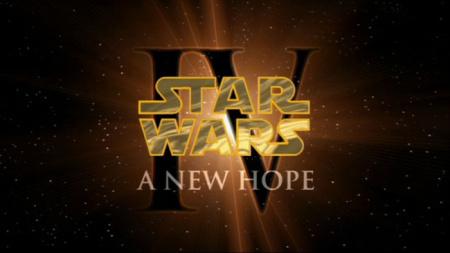 Star Wars — Episode IV: A New Hope Logo (dvdactive.com)
Star Wars — Episode IV: A New Hope Logo (dvdactive.com)
The “Hope” of the Hopeless
As the first film in the original series, Star Wars – Episode IV: A New Hope (1977) provides the basic intro to this fantastic, at times slow-moving world of the future.
It’s creaky in spots (I’ll give you that), enlivened by the occasional fly-by or Imperial star cruiser roaring overhead. Yet despite the almost insurmountable obstacles the project faced in coming to the screen (see the judicious “making of” features on the latest Blu-ray/DVD re-releases), the finished work represents a huge leap forward — an allegorical jump into hyperspace — in the art of movie-making, an oftentimes lyrical ode to gung-ho, can-do individualism. (Reader Alert: Prior knowledge of the film’s plot may be required in order to follow the story outline below.)
After a brief skirmish on board a diplomatic ship — a fracas that ends before it even gets started — we find ourselves on the outwardly lifeless desert planet of Tatooine. Mundane chores are the themes of the day as we’re introduced to one of the saga’s chief protagonists: the young and restless Luke Skywalker (Mark Hamill), in this modern interpretation of the hero’s journey from classical mythology.
This was a deliberate choice on the part of its creator, writer, director and producer, a visionary filmmaker named George Lucas. Deliberate in the sense that its depiction of routine, commonplace occurrences of daily life would soon find itself clashing with, and be far outweighed by, the necessities for survival.
Consequently the entire middle section of the movie drags — that is, up until the last third, where the ever-popular video game portion of the program happily takes over. A fast-moving, lively, and uninterrupted flight of programming fancy, this rapid-paced conclusion does, indeed, offer a new hope, a new outlook, and a new vision, at events still to come; a prescient and farsighted forecast into a technologically advanced future where all things are technically possible.
In line with this viewpoint, it’s only right that the first figures to be introduced are the robotic butler C-3PO (Anthony Daniels) and his little droid companion R2-D2 (Kenny Baker), with another Threepio unit (clad in silver, not gold casing) seen directly behind them. This is followed by the entrance of Rebel Forces in heavy duty helmets with enormous visors — ostensibly in the shape of makeshift, inverted chamber pots resting on their noggins.
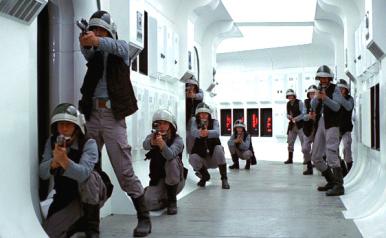
Imperial Storm Troopers burst in, and a fight ensues aboard Princess Leia’s flagship. The Rebels race down a long corridor, blasting away with their laser weapons as they go. As Artoo and Threepio cross the line of fire, we see the huge black frame and hear the heavy-breathing mechanism of the series’ main heavy, the formidable Darth Vader (voiced by James Earl Jones, body by Dave Prowse). Note to the wise: this entrance is repeated, in like manner, in Episode V: The Empire Strikes Back, as Vader penetrates the Rebel’s hidden base on the ice planet Hoth.
This leads to a quick shot of Princess Leia (Carrie Fisher) feeding Artoo the stolen plans for the dreaded Death Star, which the Galactic Empire has been building lo these many years. An irate Darth Vader orders one of the Storm Trooper commanders to “tear the ship apart until you’ve found those plans and bring me the passengers! I want them alive!” Now, now! Temper, temper! We feel his pain and anger. It seems that underneath that Nazi-style helmet lays an emotionally-wasted, angst-driven Anakin Skywalker (or Starkiller, if you go by Lucas’ original intention for that surname).
This is hardly the manner in which a follower of the Dark Side should act, but then again we’re only at the beginning of the story. At this rudimentary phase, it makes perfect sense that Vader is not in complete control of his emotions; that will surely change as the saga deepens and develops. Besides, this initial outburst makes Vader’s character all the more potent — especially after he chokes the life out of one of the Rebels with his bare hand (his left to be exact, i.e., la sinistra = Italian for “sinister”). Vader casually tosses the dead Rebel aside. So much for the future value of one’s life!
Next, we hear the Princess Leia theme for the first time (courtesy of composer John Williams), but it doesn’t last long, as the princess herself is brought before Lord Vader. Leia insists she was on a diplomatic mission to Alderaan, her home planet, while Vader points an ominous black-gloved finger at the girl and shouts, “You are part of the Rebel Alliance and a traitor – take her away!”
Again, Vader’s voice soars to a crescendo of impotent rage and fury at the petite, five-foot-nothing Leia. Talk about a height advantage, this guy is impatience personified. I wonder how he would react if he knew that Leia was, in reality, his own daughter! (Ah, but we’re getting ahead of ourselves). She is banished forthwith to one of the Death Star’s many prison cells to be, how should one put it, “interrogated.”
Paradox in Paradise
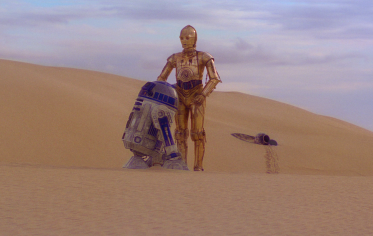
We revert back to the Tatooine Desert, where the blue sky contrasts with varying shades of red sand, a sight straight out of David Lean’s Lawrence of Arabia. Artoo and Threepio have split up and gone their separate ways. With that, there’s a brief glimpse of Threepio shouting to a lone desert transport: “Hey! HEY!!”
This smacks of a similar incident in Lawrence, where the title character and Farraj, one of his native servant boys, reach the Suez Canal. On the other side of the ridge, a British soldier shouts at them: “Who are you? WHO ARE YOU?” That soldier was none other than director Lean himself, in a brief bit. I seriously doubt that Lucas provided the voice of the guy in the desert yelling “Hey” (glad you asked: it was Anthony Daniels), but it’s a nice touch nonetheless.
Artoo happens to be inside the Jawas’ desert transport, where he meets up with other abducted droids, all rather bizarre looking. One of the captured robots reminds us of a walking gas pump, while another bears a startling resemblance to Pixar’s Wall-E (are you watching, John Lasseter?). It’s here that Artoo reunites with his old buddy, Threepio, who is overjoyed to see him.
The huge transport lumbers across the desert surface, slowly but surely. It could be a stand-in for Terry Gilliam’s gigantic wagon, last seen in The Imaginarium of Doctor Parnassus, but in point of fact it’s hard to predict what was on Gilliam’s mind, it being entirely unpredictable at best.
At last, we are introduced to our hero Luke, a geeky, cheerful lad of post-adolescent age who’s stuck on his Uncle Owen (Phil Brown) and Aunt Beru’s (Shelagh Fraser) cheerless farm. This is where we hear the name “Biggs” after Luke takes the two droids back to his place for proper grooming. Audiences unfamiliar with the original script may be perplexed at the mention of this person, a character that doesn’t appear until the last 15 minutes of the picture, and is promptly never heard from again.
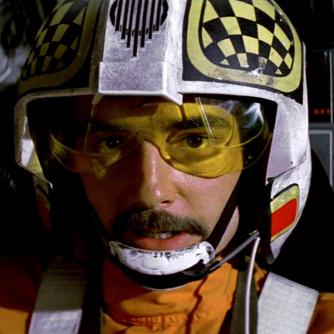
Biggs Darklighter (Garrick Hagon) is Luke’s childhood pal, recently returned from the Academy, wherever or whatever that is. According to established Star Wars movie lore, George Lucas has stashed away Luke and Biggs’ scenes (along with those of their friends Deak, Camie and Fixer) in an off-sight vault somewhere, possibly in area 51! The rumor that this so-called “lost footage” would be someday restored in subsequent revivals of the saga has been lingering for well on three decades without substantiation.
It’s my learned opinion that if maverick filmmaker Mr. Lucas ever had plans to release this “lost” footage, he surely would have done so by now. Still, the rumor persists and continues to be one of those ongoing paradoxes associated with the series from time immemorial. Perhaps with the Disney Studio’s recent acquisition of the financially lucrative franchise we may yet be treated to this innocuous side episode. Let’s hope it’s worth the wait!
Uncle Ben’s Converted Lightsaber
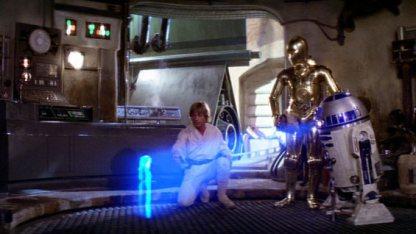
Meanwhile, after showing Luke the holographic message uploaded by Princess Leia, Artoo decides to go off on his own to seek out somebody called Obi-Wan Kenobi. “Now that’s a name I’ve not heard in a long time. A long time…” A smiling, bewigged Sir Alec Guinness plays a smiling, bewigged Old Ben, a.k.a. Obi-Wan. Ben unwittingly echoes the sentiments of the film’s focus in the above declaration, in a slogan that defines the very heart of the drama that will appear in every Star Wars manifestation thereafter: “A long time ago, in a galaxy far, far away…”
“I haven’t gone by the name Obi-Wan,” he tells the clueless Luke, “since, oh, before you were born.” That’s good to know! And we’ll be learning a heck of a lot more about this mysterious stranger in the flicks to come. Right now, Old Ben’s got his hands full with two pesky droids, the presence of Tusken Raiders, and an excitable teenager clamoring for adventure.
Soon the conversation gets around to Luke’s deceased father and Ben’s participation in the Clone Wars as a Jedi Knight. As proof, the old man hands Luke a lightsaber, claiming it once belonged to the boy’s dad: “An elegant weapon for a more civilized time.” Just then, the dastardly appellation of Darth Vader gets thrown out as the malefactor responsible for the death of Luke’s father. “Vader was seduced by the dark side of the Force,” Ben insists. Now we’re getting somewhere!
The scene shifts to a conference room in the interior of the Death Star. To lend his feature an air of legitimacy, Lucas decided to cast veteran British thespian Peter Cushing as the iniquitous Governor Grand Moff Tarkin. A bit worse for wear, the thin and wan Mr. Cushing still makes for a sinister villain.
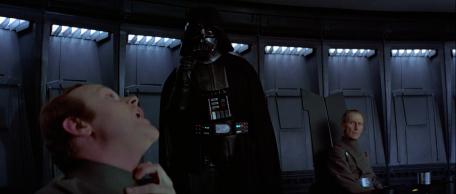
Prior to Vader’s convincing display of telepathic power, Tarkin is, for all intents and purposes, the featured bad guy. His commanding presence attempts to put order to the endless bickering carried on by his Galactic cohorts.
Not wanting to regurgitate every nook and cranny of the story, we move on to an inserted scene with Han Solo (Harrison Ford) and Jabba the Hutt — or more correctly, a digitally enhanced Jabba (or “DEJ”) speaking in Huttese. To these eyes, there’s something unreal about this CGI-created Jabba. Actor Ian McNeice, who portrayed the Baron Harkonnen in the Sci-Fi Channel’s adaptation of Frank Herbert’s Dune, was hired to stand in for the fleshy slug-like Hutt.
Also making his screen debut is the notorious bounty hunter Boba Fett, who is part of Jabba’s advance guard, to include the green-skinned creature known as Greedo, an aptly chosen moniker for such a loathsome smuggler. Greedo gets blown away by Han Solo in the Cantina Bar at the Mos Eisley space port. What a way to go! In the revised version of this scene, Greedo is made to fire first, thus negating the effect of Solo’s wanting to gain the upper hand in their encounter. Hey, a smuggler’s got a right to protect himself, right? Think of it as an intergalactic re-creation of the “stand-your-ground” law.
Victory is Its Own Reward!
All in all, in comparison to the later trio of movies — Episodes I, II and III, to be exact — there’s a palpable realism and solidity to the early pictures that are most welcome here and completely missing further on; a feeling of sturdiness, of real physical structures surrounding the all-too human figures that no CGI-created atmosphere can beat or replicate.
When Luke’s old buddy Biggs reemerges onscreen, his usefulness is made evident in vouching for his friend’s piloting skills. Once that business is out of the way, we’re off to outer space and video land, the first of many such happenstances. Let’s take a closer look at an earlier scene aboard Han Solo’s Millennium Falcon spaceship.
Luke attempts to master the Jedi art of stretching out with one’s feelings by covering his sight with a helmet, while preventing a floating “seeker,” a chrome baseball-like automaton with built-in antennae, from hitting him with its blood-red laser beam. If this isn’t a precursor to virtual reality games, I don’t know what is.
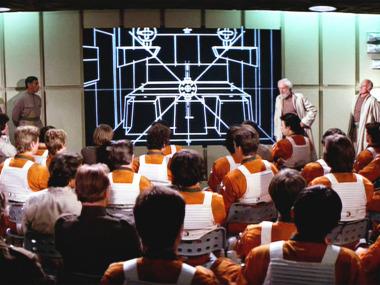
We fast-forward to Rebel Base Headquarters, where the leader General Dodonna gives a mid-1970s reenactment of the St. Crispin’s Day speech — you know the one, the rallying cry that Shakespeare’s Henry V gave his troops before the English victory over the French. Dodonna’s discourse, however, is not very inspiring. In fact, it’s chock full of techno-babble. But he concludes it with the line, “And may the Force be with you,” which is certainly not the last time we’ll be hearing this catchphrase.
The good general does look incredibly like veteran film director John Huston. In point of fact, the actor who played him, a guy named Alex McCrindle, even captures some of Huston’s voice mannerisms and cadences.
Perhaps it’s another of those “art imitates life” moments we hear so much about. We do know that Huston made his residence in western Ireland at the time of the Stars Wars shoot. In addition, outside of the desert sequences in Tunisia, the bulk of film was shot at Pinewood Studios in the UK. No matter, the speech has the desired effect of getting the star pilots to perform at their best. And, most important of all, both Luke and Han are reunited and go on to save the day. Han even gets a chance to redeem himself in the eyes of his friend (and the gorgeously bedecked Princess Leia) in the Throne Room sequence.
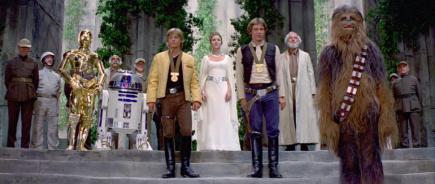
By the way, the additional scenes inserted by Lucas for the 1997 Special Edition release, in the digitally enhanced realm, add little to the film’s overall structure and content. On the contrary, these so-called “improvements” tend to favor the original productions, which are parsecs removed from the upgraded versions.
If anything, they prove how much better the earlier films were as opposed to these bowdlerized and patently ersatz enhancements.
(To be continued)
End of Part Four
Transcript of dialog from George Lucas’ original Star Wars screenplay was taken from the Public Version of same
Copyright © 2014 by Josmar F. Lopes

